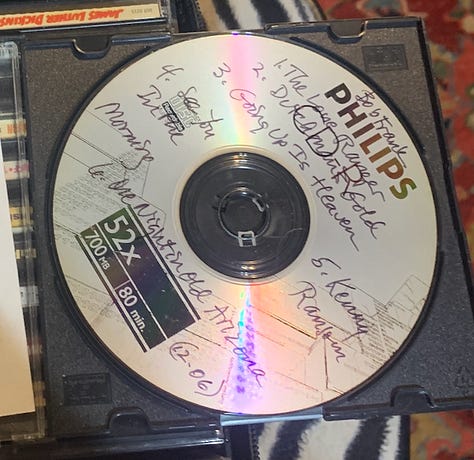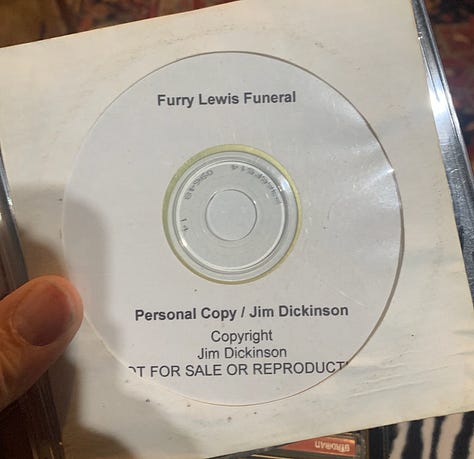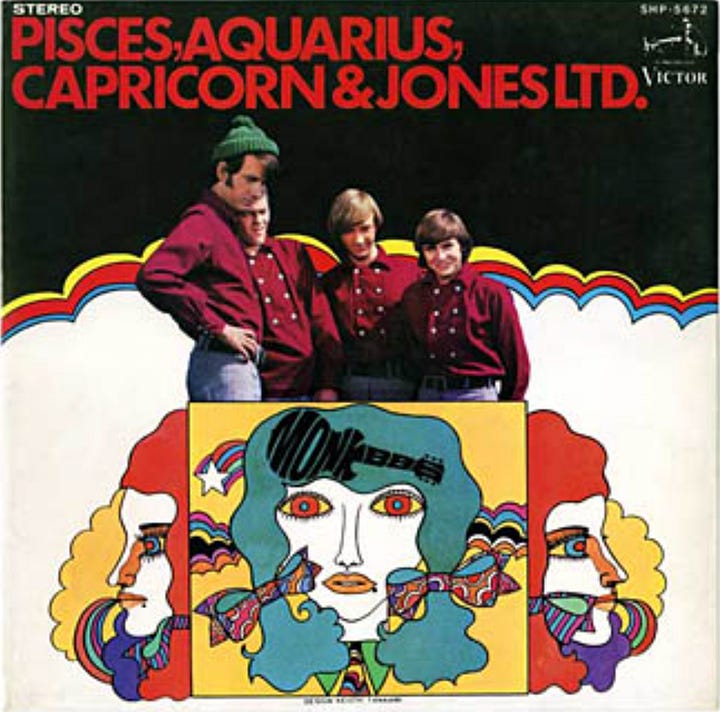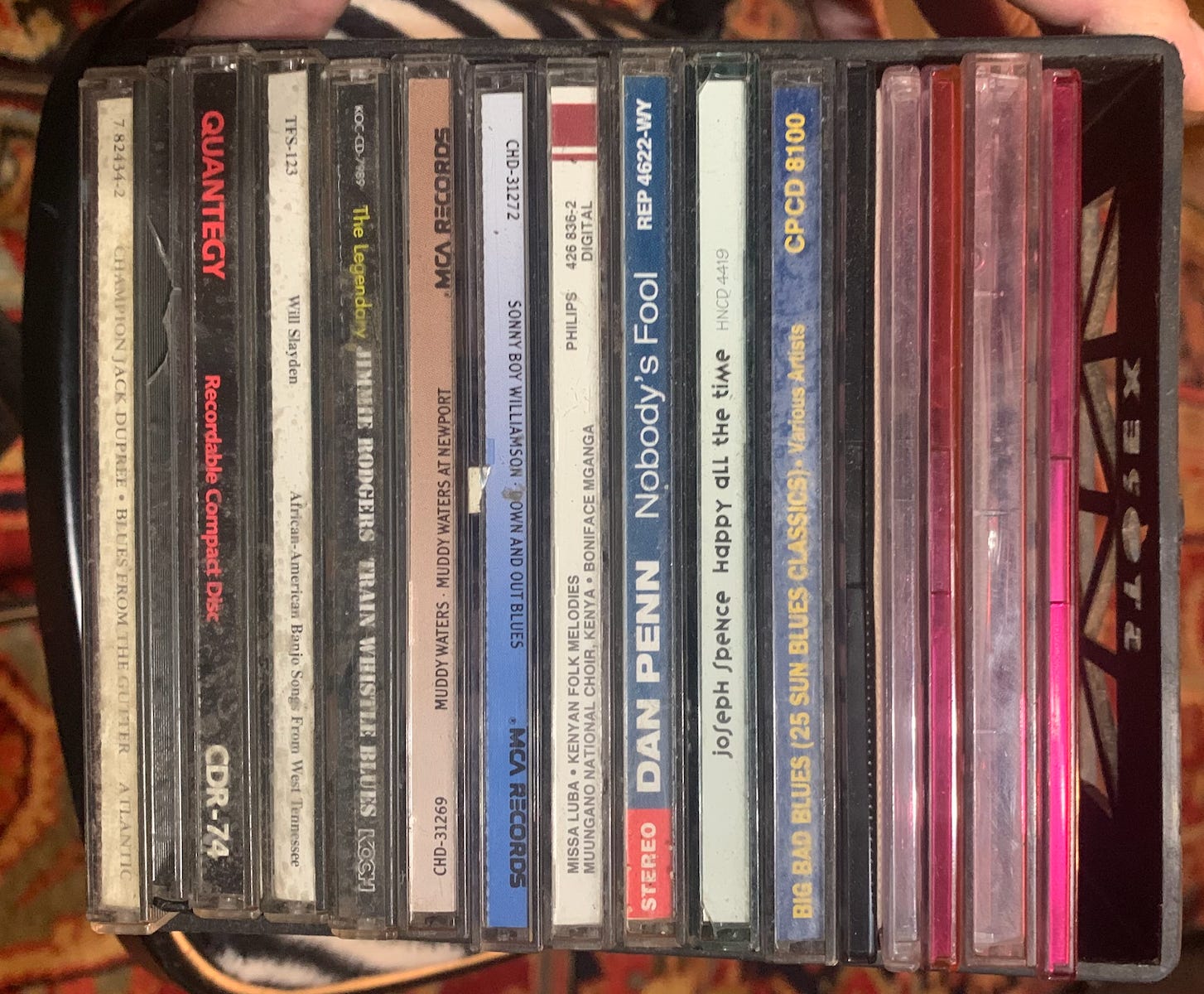Dickinson's Black Box
"The difference between false memories and true ones is the same as for jewels: it is always the false ones that look the most real, the most brilliant."-Salvadore Dalí
Last week marked the 15th anniversary of the passing of Jim Dickinson. As his book title reads, I’m Just Dead, I’m Not Gone. For an artist who left behind so many incredible productions, performances and musical participations, he is absolutely right…
Jim Dickinson brought a black box with him to every session he oversaw as producer…at least during the era in which we worked together.
I first espied the box during the Texas Tornados sessions at Arlyn Studios in Austin. It was sitting on the mixing board in the main studio, a two columned row of CDs, bearing their colorful spines. I paid no attention to it, being more absorbed in watching Doug Sahm conduct a horn section while writing arrangements in the air, or Dickinson overseeing Sahm and Freddie Fender sing a two-part harmony together old school, no overdubs, from start to finish, or watching Flaco Jimenez squeeze and bend his accordion in his unique, almost free-jazz style, with Bajo Sexto accompanist Max Baca picking up the slack. Too much amazement was going on around me to think about anything else.
A year later, Jim was producing a Mudhoney session at Ardent Studios in Memphis. The session that would lead to Tomorrow Hit Today, the band’s great swan song Reprise record. During a down moment, I saw Jim digging through that same box, looking for something. The box, he said, was filled with CD versions of his favorite records from his collection as well as other records he had produced; the curated discs were points of reference for him, connectors to music that had inspired him along his journey, bars to aim for that he would often tap into when making a new record (at the time, he was looking for either a specific guitar sound or style as he was gearing up for overdubs). He would curate the box for each record he made, with some records, like Mingus’ Ah Um, Elvis Presley’s Sunrise, and Miles Davis’ Sketches of Spain being staples that he never left home without. The box was like a Keith Haynes painting, a portrait of Jim Dickinson via the music that he loved.
I learned going through the box that day of Dickinson’s love for musicals, the box featuring the original cast recordings of The Fantastics and Finian’s Rainbow: certain songs, certain song arrangements, certain vocal performances really moved him, challenged him to “beat them” when he pressed the red record button in the studio with the right kind of musician. Unsurprisingly, he loved the blues: Muddy Waters, Sonny Boy Williamson and jazz from its earlier innovators like Baby Dodds through the later journeymen like Charlie Parker to Ahmad Jamal. He loved the great vocalists of the 20th century, bringing with him CDs of Edith Piaf, Marlene Dietrich (“haunting!”), Dinah Shore and Eddie Condon. Jim explained that it was all about the soul of the singer and the musical arrangements surrounding their performances that enticed him. I would later be tasked with helping Jim’s son Luther Dickinson and his wife Mary Lindsey edit his memoirs after his passing, and learned that most of the crooner CDs contained recordings DNA’d into his soul when listening from the crib.
The most interesting parts of the box to me were the records that I did not know…that I needed to know. He pulled out Weary Blues, a poem by Langston Hughes that Hughes read under the music of Charles Mingus: one of the greatest writers paired with one of the greatest composers (here is Hughes performing part of the poem on television). He pulled out Blues From The Gutter by Champion Jack Dupree, a pianist that Seymour Stein always raved about but whose classic recordings I had yet to hear. That record has become one of my all-time favorites, featuring amazing guitar work by the obscure Ennis Lowery and a rhythm dictated by Dupree that slows time down to a blues saunter with every play. I knew Mose Allison but not his concept/fantasy record The Transfiguration of Hiram Brown, I knew The Holy Modal Rounders through their contribution to the Easy Rider soundtrack but had never listened to the pure anarchy that is Indian War Whoop. All varied shapes and sizes of sound, yet all somehow fitting together with warm audio colors and righteous, dark musical imaginations. Jim Dickinson’s black box was a web of music that fit together as Harry Smith’s Anthology of American Folk Music fit together: disparate recorded landmarks together telling a very interesting, incredibly deep and enticing story; a wooden recipe box of past tastes that Dickinson could flip through as his head heard what the artist in the studio was trying to achieve.
Last winter, while co-producing a record with Luther Dickinson at Jim’s Zebra Ranch Studios in Coldwater, Mississippi, Luther miraculously pulled out the black box as well as two other CD boxes that contained overflow, the CDs that got swapped in and out of the main box. Dan Penn’s Nobody’s Fool. Joseph Spence’s Happy All The Time (SOOO GOOD). More Edith Piaf. They include many of Jim’s solo records and various band projects as well as unreleased recordings from Memphis luminaries like honky-tonk guitarist Lee Baker, whose contributions to Big Star’s Third Record made him an obscure legend…who was not known for his solo output, which made the recordings present here a found treasure. There are three CDs worth of Lee Baker included, as well as CDs of unreleased Bob Frank tracks, whose Vangaurd self-titled debut became a record collector salivatory object, prompting Light In The Attic to release a double CD of outtakes years later. The alt black boxes featured a lot of music from bluesman Furry Lewis including the album Take Your Time, a CDR of music from his funeral, as well as the Delta X 3 CD that I released on Birdman years ago, a compilation that contains Furry Lewis recordings Jim made in the 70s.



As an eternal searcher for great music that I have not yet heard, finding the black box opened up musical doors that I had not known about previously: the best way to get into music is through introductions by fellow zealots. And for that reason alone, it is a prized item that felt almost sacred to hold once again when I was last down in Mississippi. But Dickinson’s black box also offers a glimpse into the workings of a producer-par-excellence and the musical references that producer kept when making records. Maybe somewhere within the included records is the basis of Jim’s performance on The Rolling Stones’ Wild Horses (of which he played piano) or on one of the numbers from Aretha Franklin’s In The Dark or Bob Dylan’s Time Out Of Mind. Maybe somewhere in the reverberations answers questions to the sounds found on Big Star’s Third Record or his many film soundtracks or his pinnacle solo release, Dixie Fried.
The black box is a treasure of inspired sounds and a portrait of a great sound creator…a dark and sweet shadow left behind as a reminder of a large, thoughtful and deeply engaged life that has passed.
What music would you include in your black box that would would want to always access now and leave behind for others to find later?
We just cme back from Martha’s Vineyard fining this in our inbox: an incredible deep dive into the making of Jaws and the celebrations that are coming: “Fifty years ago, when Universal Studios came to Martha’s Vineyard to shoot the seminal movie Jaws, neither side knew what they were getting into – or what they would get out of it.” (thank you Lou Cove for the hostmanship on the Island and for turning me on to this article…)
Nick Cave turns his back on 'disgraceful self-indulgence'
I have previously dedicated a Signal to my difficult experience being the US A&R person for Nick Cave. The day I published it, Shane MacGowan, a friend and another artist I worked with (having a much better experience working with) passed away and Nick performed Rainy Night In Soho a few days later at Shane’s funeral. It was a thing of shattered beauty. Since then, I have for the first time in years gone back and listened to the music of Nick Cave and the Bad Seeds…the records I worked on, the records I fell in love with as a teenager…the newer, darker, beautiful records of tragedy following losing his children. The above interview was recently shot and aired on Australian TV and dives deep into Caves self evolution over the past years, blowing me away at how reflective, critical and open he is: how his view of his art has changed, how his view of the important things in life has shifted. And then there is his recent appearance on Late Night where he is given a platform to offer advice for dealing with deep grief.
Dalí’s Deep Love of European Art Traditions Resurfaces in a Major Museum Show
I went to see this show with the family last week and absolutely loved it. I forget how brilliant Salvadore Dalí is….given his pop stardom, I forget that it is based in true artistic genius. And to see a very thoughtfully curated show that includes Goya prints and Bosch related pieces of art done, presented to show his influences and the through line to how it impacted his art was fascinating. Even my 11-year-old loved looking deep into Dalí’s paintings, finding the hidden images.
Journalist Tricia Romano’s piece is a true mystery, digging into all possibilities of what happened to Joe Wood on Mount Rainer…a great read.
Reading Is Funktamental - A Pod About Books About Music
I am very select with both reading music books and listening to music-oriented podcasts. That being said, this podcast kind of kills two birds with one stone…and does it very well! Example: I would not read a memoir by Phil Manzanera…nothing personal: I LOVE ROXY MUSIC and much of the other stuff he has been involved in. But the podcast segment with him around his book was great. Thanks Brooke Wentz for turning me on to it.
Keiichi Tanaami, Artist Who Reinterpreted Pop for a Japanese Audience, Dies at 88
The crazed, psychedelic art of Keiichi Tanaami did not only reinterpret the psychedelic art movement of his time (as the article’s title suggests) but helped fortify it…add to it…expand upon it. His website is filled with mind-melting images that he was so good at creating. RIP (thank you Steven Baker for sending me the album covers below)….
Thirteen Essential Poetry Collections That Pass the Test of Time
I might have posted this when it was published three years ago…but came upon it when searching out the work of a specific poet and thought I would post it again. A fine roadmap into some great poetic vision.
Nominate for the Library of Congress' National Recording Registry
YOU can nominate a recording for the National Recording Reg. I just nominated The Flaming Lips’ Soft Bulletin and The Monkee’s Headquarters (planning to add more when I have more time). Might as well load it up with our favorites!
A Kamala Harris tee paying homage to Sonic Youth’s Goo? Gotta have it. I got mine yesterday. I got it in blue. I recommend getting them in the size larger than you are used to. They are kool things. Thanks to Jay Babcock of the fab Landline for turning me on to it….
Kwame Anthony Appiah Awarded Kluge Prize
“I am urging that we should learn about people in other places, take an interest in their civilizations, their arguments, their errors, their achievements, not because that will bring us to agreement, but because it will help us get used to one another.”― Kwame Anthony Appiah
Annie Leibovitz lists Marin County farm at $8.995 million
“Known as The Hideway, the 65-acre Bolinas retreat’s history includes another famous photographer, Ansel Adams, who captured images of a weathered barn on the farm in 1932. One of the pictures he took there, “Stump and Barn Near Olema,” has been featured in a traveling Smithsonian exhibition. Prior to Leibovitz’s tenure, the farm at 605 Horseshoe Hill Road was owned and stewarded by Warren Hellman, San Francisco financier and founder of the Hardly Strictly Blue Grass music festival.”
Enemy of Death
By: Salvatore Quasimodo
You should not have
ripped out your image
taken from us, from the world,
a portion of beauty.
What can we do
we enemies of death,
bent to your feet of rose,
your breast of violet?
Not a word, not a scrap
of your last day, a No
to earth’s things, a No
to our dull human record.
The sad moon in summer,
the dragging anchor, took
your dreams, hills, trees,
light, waters, darkness,
not dim thoughts but truths,
severed from the mind
that suddenly decided,
time and all future evil.
Now you are shut
behind heavy doors
enemy of death.
Who cries?
You have blown out beauty
with a breath, torn her,
dealt her the death-wound,
without a tear
for her insensate shadow’s
spreading over us.
Destroyed solitude,
and beauty, failed.
You have signalled
into the dark,
inscribed your name in air,
your No
to everything that crowds here
and beyond the wind.
I know what you were
looking for in your new dress.
I understand the unanswered question.
Neither for you nor us, a reply.
Oh, flowers and moss,
Oh, enemy of death.
(For Rossana Sironi)




“Did you say the stars were worlds, Tess?"
"Yes."
"All like ours?"
"I don't know, but I think so. They sometimes seem to be like the apples on our stubbard-tree. Most of them splendid and sound - a few blighted."
"Which do we live on - a splendid one or a blighted one?"
"A blighted one.”
―Thomas Hardy, Tess of the D’Urbervilles



















The whole Jack Dupree catalog is essential. Thank you for this piece!
Reminded me of the photos I took of Alex Chilton’s cds at his home in New Orleans, which I sent to you via text. Please feel free to share them.